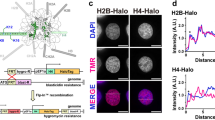Summary
Human chromosomes and their fibers were studied by electron microscopy as whole mounts in metaphase and interphase after surface spreading and critical point drying and as thin sections after fixation and embedding. Chromosomes and interphase nuclei were composed of irregularly coiled fibers measuring about 200 to 300 Å in width. Thinner and straighter chromosome fibers were produced by stretching or NaCl extraction. Thin sections of metaphase chromosomes showed 200 Å wide granular outlines containing regularly coiled 70–80 Å wide fibrils. These smaller substructures appeared hollow with a 20 Å thick electron dense wall. The possible arrangement of the DNA molecule as a tertiary coil in the chromosome fiber of living cells is suggested.
Zusammenfassung
Menschliche Chromosomen und-Fäden in Meta- und Interphase wurden als Totalpräparate nach Oberflächenspreitung und Kritischer-Punkt-Trocknung und als Dünnschnitte nach Fixierung und Einbettung mit dem Elektronenmikroskop untersucht. Metaphase-Chromosomen und Interphase-Kerne fanden sich als aus unregelmäßig gewundenen Fäden von 200–300 Å Dicke bestehend. Durch Dehnung und NaCl-Extraktion wurden diese Chromosomenfäden dünner und gerader. Dünnschnitte der Metaphase-Chromosomen zeigten 200 Å breite granuläre Fadenkonturen, die regelmäßig gewundene, spiralig angeordnete 70–80 Å breite Fibrillen enthielten. Diese fibrillären Unterstrukturen erschienen hohl mit einer 20 Å dicken elektronendichten Wand. Die mögliche Anordnung des DNA-Moleküls als Tertiärschraube im Chromosomenfaden lebender Zellen wird diskutiert.
Similar content being viewed by others
References
Abuelo, J. G., Moore, D. E.: The human chromosome. Electron microscopic observations on chromatin fiber organization. J. Cell Biol. 41, 73–90 (1969).
Anderson, T. F.: Techniques for the preservation of three-dimensional structure in preparing specimens for the electron microscope. Trans. N.Y. Acad. Sci., Ser. II, 13, 130–134 (1951).
Cole, A.: A molecular model for biological contractility: Implications in chromosome structure and function. Nature (Lond.) 196, 211–214 (1962).
Dupraw, E. J.: The organization of nuclei and chromosomes in honeybee embryonic cells. Proc. nat. Acad. Sci. (Wash.) 53, 161–168 (1965).
—: Evidence for a “folded-fibre” organization in human chromosomes. Nature (Lond.) 209, 577–581 (1966).
—, Bahr, G. F.: The arrangement of DNA in human chromosomes, as investigated by quantitative electron microscopy. Acta Cytol. 13, 188–205 (1969).
Fong, P.: Packing of the DNA molecule. J. theor. Biol. 15, 230–235 (1967).
Gall, J. G.: Chromosome fibers from an interphase nucleus. Science 139, 120–121 (1963).
—: Chromosome fibers studied by a spreading technique. Chromosoma (Berl.) 20, 221–233 (1966).
Hay, E. D., Revel, J. P.: The fine structure of the DNP component of the nucleus. An electron microscopic study utilizing autoradiography to localize DNA synthesis. J. Cell Biol. 16, 29–51 (1963).
Lampert, F.: Feinstruktur und Trockengewicht menschlicher Chromosomen. Quantitative Elektronenmikroskopie. Naturwissenschaften 56, 629–633 (1969).
Maestre, M. F., Kilkson, R.: Intrinsic birefringence of multiple-coiled DNA, theory and application. Biophys. J. 5, 275–287 (1965).
Mirsky, A. E., Burdick, C. J., Davidson, E. H., Littau, V. C.: The role of lysine-rich histone in the maintenance of chromatin structure in metaphase chromosomes. Proc. nat. Acad. Sci. (Wash.) 61, 592–597 (1968).
Pardon, J. F., Wilkins, M. H. F., Richards, B. M.: Super-helical model for nucleohistone. Nature (Lond.) 215, 508–509 (1967).
Person, C., Suzuki, D. T.: Chromosome structure — a model based on DNA replication. Canad. J. Genet. Cytol. 10, 627–647 (1968).
Ris, H., Chandler, B. L.: The ultrastructure of genetic systems in prokaryotes and eukaryotes. Cold Spr. Harb. Symp. quant. Biol. 28, 1–8 (1963).
Salzman, N., Moore, D., Mendelsohn, J.: Isolation and characterization of human metaphase chromosomes. Proc. nat. Acad. Sci. (Wash.) 56, 1449–1456 (1966).
Schwarzacher, H. G., Schnedl, W.: Elektronenmikroskopische Untersuchungen menschlicher Metaphasen-Chromosomen. Humangenetik 4, 153–165 (1967).
Solari, A. J.: The ultrastructure of chromatin fibers. II. The ultrastructure of the loops from sea urchin sperm chromatin. Exp. Cell Res. 53, 567–581 (1968).
Stoeckenius, W.: Electron microscopy of DNA molecules “stained” with heavy metal salts. J. biophys. biochem. Cytol. 11, 297–310 (1961).
Wolfe, S. L.: The effect of prefixation on the diameter of chromosome fibers isolated by the Langmuir-trough-critical point method. J. Cell Biol. 37, 610–620 (1968).
Author information
Authors and Affiliations
Additional information
Supported by a grant (La 185/3) of the Deutsche Forschungsgemeinschaft.
Rights and permissions
About this article
Cite this article
Lampert, F., Lampert, P. Ultrastructure of the human chromosome fiber. Hum Genet 11, 9–17 (1970). https://doi.org/10.1007/BF00296298
Received:
Issue Date:
DOI: https://doi.org/10.1007/BF00296298




